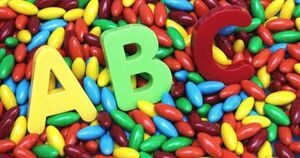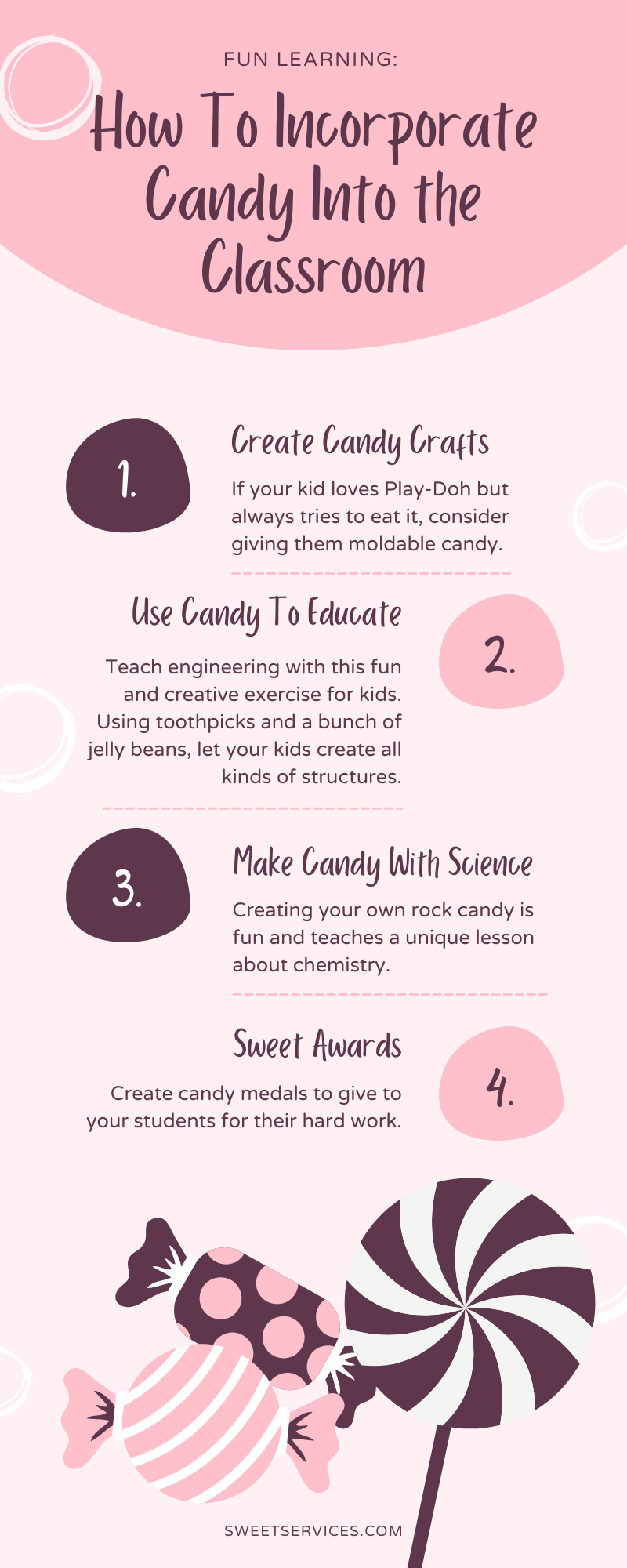
Everyone knows that kids love candy. When sweets are part of the mix, children get excited, which is why it’s great to use candy as a teaching agent. If you’re a teacher, knowing how to incorporate candy into the classroom will give you all sorts of ways to motivate your students. It’s fun to learn with candy; there are many difference experiments to uncover. Discover 14 candy activities.
Create Candy Crafts
Painting With Candy
You can find multiple ways to paint with candy. It’s a fabulous way to get some use out of leftovers. You can extract the color from certain candies to use as glossy water paint, or you can change the texture of candies so they become edible paint. For instance, if you pour cornstarch and water over Starbursts and similar candies, they’ll turn into a thick paste that kids can spread over paper. You can also pour corn syrup over Skittles or jelly beans. It will remove the color and create a tasty paint.
Starburst Sculptures
If your kid loves Play-Doh but always tries to eat it, consider giving them moldable candy. Treats like Starbursts and Laffy Taffys are like clays you can sculpt. They’ll enjoy snacking while making masterful pieces of art. Whether they create animals or images of themselves, they’ll love sculpting with gummies.
Jell-O Art
Get creative with this unique idea for edible art. To create Jell-O art, you’ll need to make Jell-O and pour it into squeeze bottles—such as clean glue bottles. Then, your students can use the gelatin mixture to draw pictures and create art. Once it solidifies, they can eat it.
Use Candy To Educate
Jelly Bean STEM Activity
Teach engineering with this fun and creative exercise for kids. Using toothpicks and a bunch of jelly beans, let your kids create all kinds of structures. This way, they’ll learn about 2D and 3D shapes. Also, you can teach them about stability and durability when you begin constructing bridges and more with these simple materials.
Marshmallow Constellations
Even kids love to look at the stars and moon. If your students want to know more about constellations, use sweets to teach them. You can use toothpicks and mini marshmallows to show them how constellations look. Design each constellation you see in your sky by envisioning each marshmallow as a star. Lay out the marshmallows in constellation patterns and use toothpicks to connect them.
Pro Tip: Let your students get creative and form their own constellations. They can decide what they represent.
Peep Density Experiment
Experiment with weight and density with Peeps. Using different liquids, you can study how well Peeps float. Try water, oil, soap, and corn syrup to teach kids about density.
Sink or Float
You can play this game with any type of candy. Simply ask your students if they think something will sink or float when placed in water. You can combine this activity with the density experiment to make it more interesting for your students.
M&M Math
Candy is excellent for teaching math, and M&Ms are most popular for this purpose. Use them to teach your kids about counting, fractions, percentages. For instance, kids can pour out a portion of M&Ms from the bag and then count them all to determine what percentage is still inside. Also, you can determine monetary amounts for different candies and teach students to shop and budget.
Water Displacement With Candy
Show kids what happens when you add something to a cup of water. Start by drawing a line where the water is in the cup and ask your students how high they think it will rise. They can try this experiment themselves by adding a few pieces of candy at a time or many at once. Jelly beans work well for this experiment.
Make Candy With Science
Rock Candy
Creating your own rock candy is fun and teaches a unique lesson about chemistry. To create rock candy, boil sugar, water, and food dye in a pan. Then, pour the contents into jars. Place a stick in the jar and wait about a week for the candies to form. The best part is eating them after they’re finished.
Edible Slime
You can make edible slime from several different types of candies. One of the most popular to use are Starbursts, to which you add powdered sugar and cornstarch. The cornstarch breaks down the gummy candy while the sugar turns it into an icing-like slime. If you use Sour Patch Kids or gummy bears, you’ll also need to add cooking oil. Edible slime is unique and fun.
Candy Play-Doh
Kids who love Play-Doh will love the type you can eat. Using Peeps, coconut oil, and powdered sugar, you can create colorful putty that doesn’t contain toxins. The mixture is moldable and makes your fingers taste delicious.
Sweet Awards
Candy Medals
Create candy medals to give to your students for their hard work. Tape a ribbon to the back of a candy bar so that it makes a necklace. You can make medals with candy like Smarties or the class’s favorites. Give everyone an award so no one feels left out. You can make them from Reese’s Cups, M&Ms, York Mint Patties, and more.
Candy Toss
One of the easiest ways to use candy in the classroom is as a motivator. Get students to answer questions by passing out treats. Even if they get the answer wrong, you should reward them with a piece of candy for taking a chance and speaking up. Plus, tossing candy to your students is a great way to build hand-eye coordination. You can also use it during pop quizzes for kids who give the right answers.
Many ways to incorporate candy into the classroom exist. Consider the ages and abilities of your students when choosing activities they can achieve. Whether you teach art or provide STEM education, candy is a great way to get everyone involved and thinking creatively. You can teach math, science, and more with sweets. Motivate your students when you place an order for bulk hard candy from Sweet Services today for all your candy experiments.


Leave a Reply
You must be logged in to post a comment.